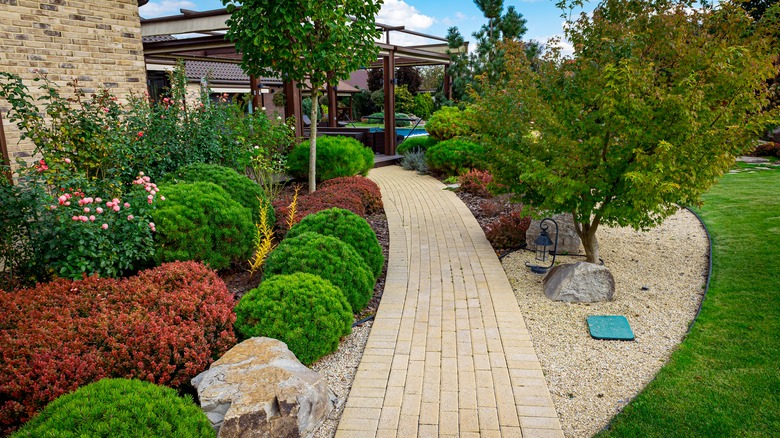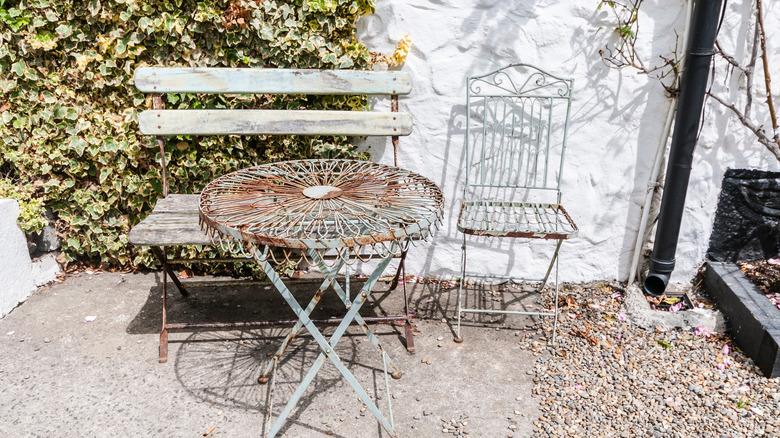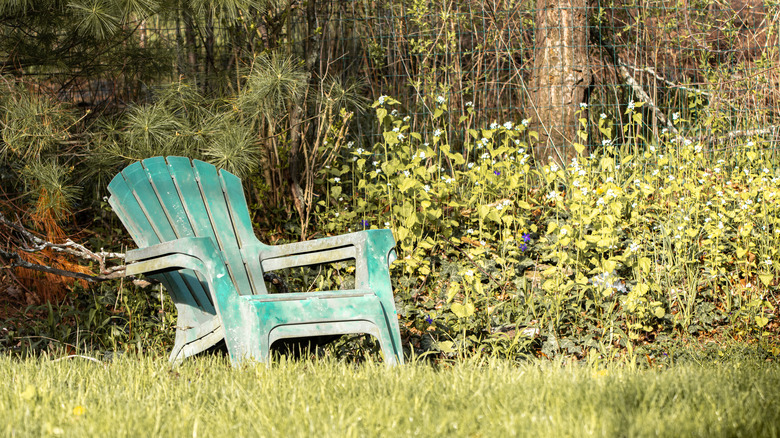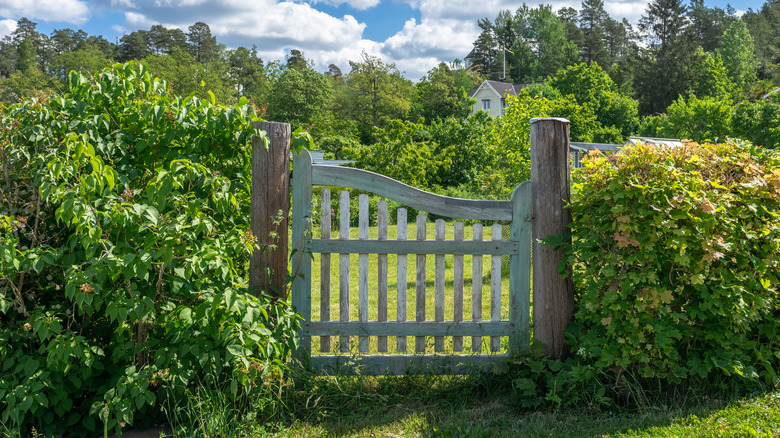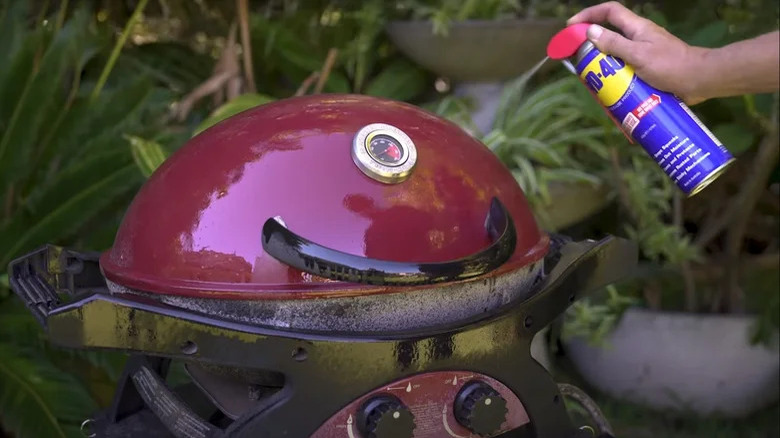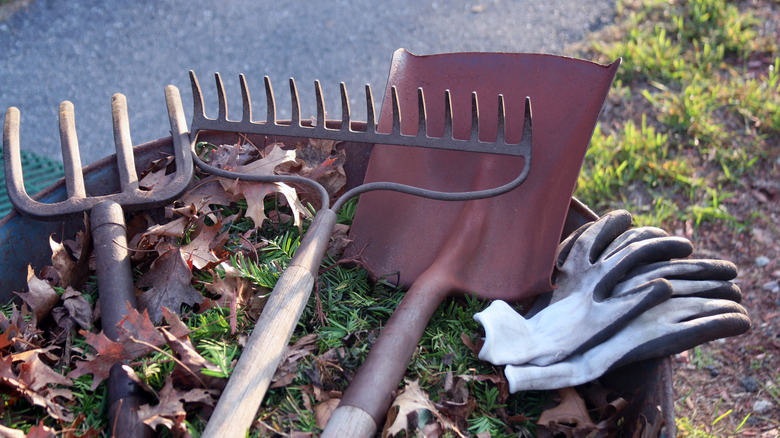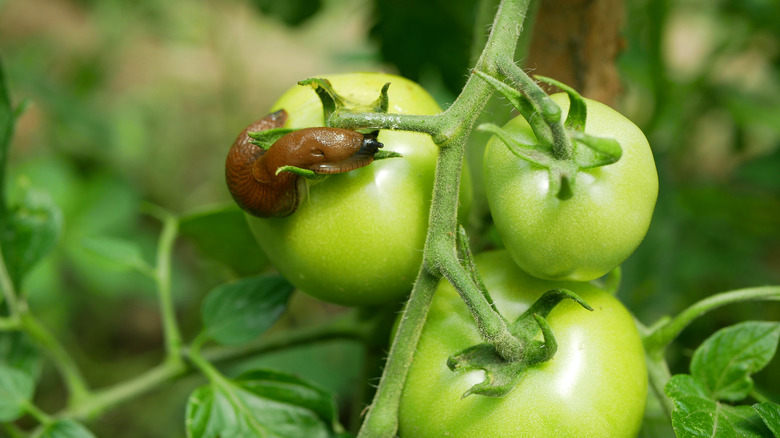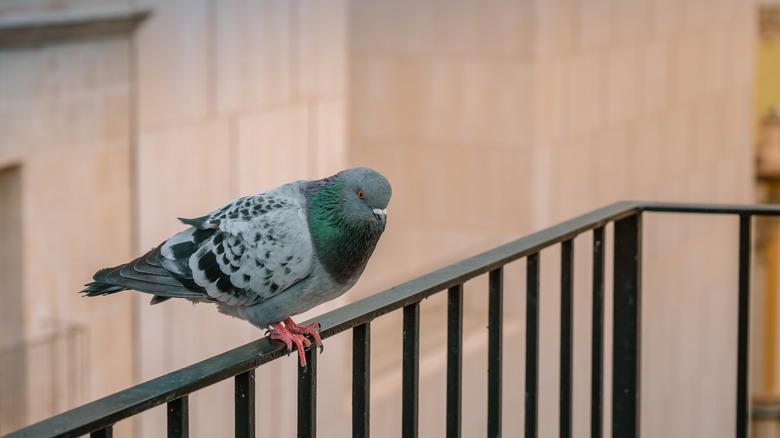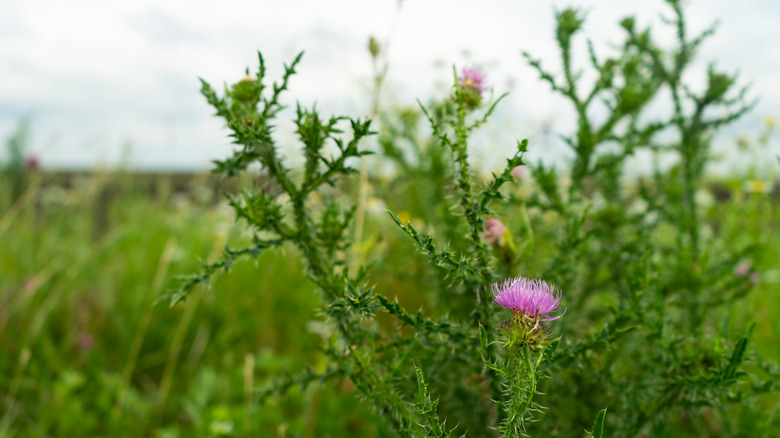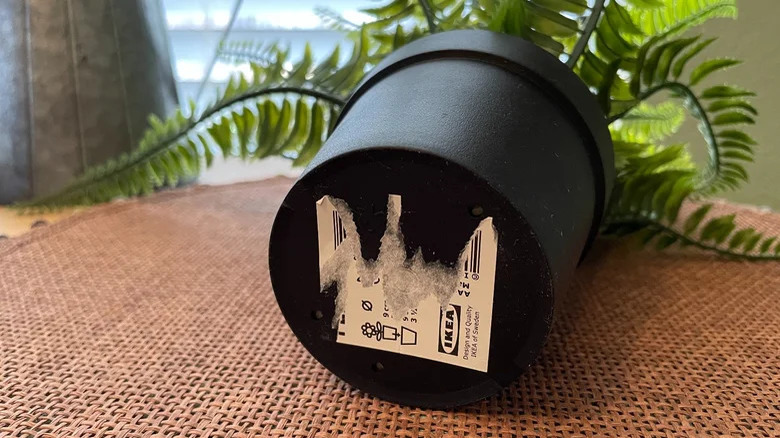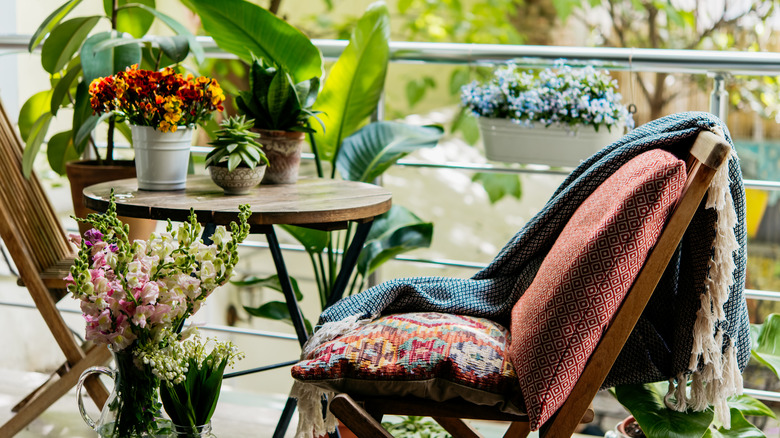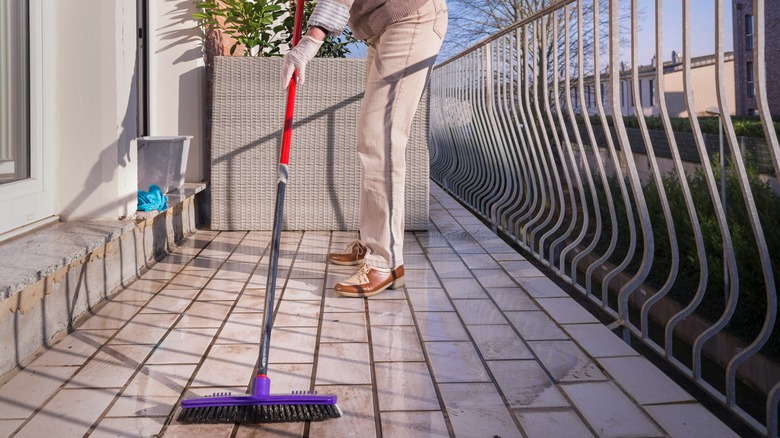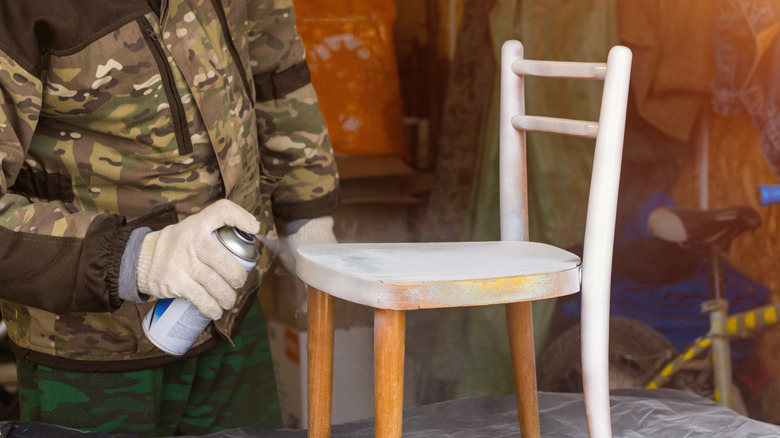Make Big Changes To Your Yard With The Help Of WD-40
Take a peek into most utility cupboards, and you'll find a can of WD-40. This multi-use product is so versatile that its list of uses spans thousands of tasks, both indoors and outdoors. An iconic blue and yellow can of this formula can help you make big changes around your home, including in your yard or garden.
Starting with the basics, let's break down the name WD-40. "WD" stands for "Water Displacement," and "40" refers to the fact that it's the "40th formula" — the iteration that chemists decided was just right. The formula recipe is a secret, but the brand shares that it's a blend of lubricants, anti-corrosion agents, and penetrating, water-displacement, and soil-removing ingredients. WD-40 drives out moisture, lubricates, protects, and removes grime. These features make it useful for many jobs, from taking the squeak out of door hinges to restoring your patio furniture. We've rounded up some practical outdoor uses for WD-40. A can of this affordable home helper can make yard maintenance easier, and make your outside spaces look much nicer too.
Tidy up and restore furniture
Exposure to the elements can make metal furniture look dingy and make your outdoor space look less inviting. There's no need to replace worn patio furniture — a can of WD-40 might be enough to make your set look like new. One of WD-40's well-known uses is as a rust remover, so use it to transform rusty metal furniture. Spray WD-40 on the corroded surface, let it sit for around 10 minutes, and then scrub it off using a gentle abrasive scrubber. A soft bristled brush can remove debris without scratching the metal underneath. Since WD-40 can also temporarily protect from rust, finish up by wiping a thin layer of the product along your metal furniture. Just make sure to remove any larger bits of residue since WD-40 can leave marks on fabric cushions and accessories.
Mildew often accompanies rust, especially in wetter climates. WD-40's grime-removing properties are also effective for removing the green tinge that plagues metal furniture. Similar to clearing off rust, spray a layer onto mildewed areas, let sit for a few minutes, and then wipe off.
Restore plastic outdoor furniture
Plastic patio furniture can fade and lose its color over time. If your outdoor plastic furniture is looking dull and sad, revive its color and shine with WD-40. WD-40 is safe to use on most plastic surfaces, except those made from polycarbonate and clear polystyrene plastic — avoid use on these two materials.
To restore plastic furniture, you'll just need a can of WD-40 and a soft, clean cloth. Depending on how dirty your furniture is, you may also need some cleaning tools; a sponge and a bucket of soapy water are usually plenty. First, clear the furniture of any dust and muck. If there are stubborn spots of tree sap or bird poop, you can spray a bit of WD-40 on the spot and let it soak, then it should be easier to remove with a sponge. Once the furniture is clean, spray it all over with a can of WD-40. Rub the product into the plastic with a dry, clean cloth, which will immediately restore the plastic to a nicer-looking condition. If any excess product is left on the surface, wipe it away.
Take care of squeaky hinges and wheels
Sticky garden gates, rusted swing sets, and creaky screen doors — all these squeaks can really disturb the peace when you're relaxing outdoors! Turn your yard into a quieter outdoor oasis by lubricating these hinges. Of course, WD-40 is useful year-round, but we recommend setting a reminder to complete this task in early Spring. It's a good time to clean up any rust that came from wet winter weather, and it will prepare your outdoor space for the upcoming months of use.
There are plenty of outdoor areas you can treat for squeaks and sticky hinges. Some spots to check include exterior doors, garage doors, and garden gates. Also, check your outdoor furniture and accessories; WD-40 can help swinging patio chairs, grill wheels, sticky ladder mechanisms, and folding chairs work more smoothly and quietly. You can even spray WD-40 on your wicker furniture to remove the annoying squeaking sound the material sometimes makes. To get into any hard-to-reach spots, consider grabbing a can of WD-40 Ez-Reach, which comes with a long and flexible straw to direct the formula into tight spaces.
Clean up your grill
If you love to grill, you might consider your outdoor grill one of the most important pieces in your yard. But even if you don't use it too often, you'll want it to look nice — a big, dirty barbecue can be an eyesore in your backyard. WD-40 can be used to clean your grill's exterior and interior to get it looking and feeling clean in time for grilling season. You'll need the typical supplies you usually use to clean a grill, including a wire grill brush, a sponge, warm, soapy water, a clean cloth, and in this case, WD-40.
Always start with a cold grill. You can use warm, soapy water for an initial clean where needed. To remove residual sticky grease, spray WD-40 all over the outside of the appliance, let it sit for a few minutes, and then use a dry cloth to wipe the solvent and grime off. Regarding the grill's inside, WD-40 is an excellent degreaser for the stainless steel racks. Take them out, spray them with the solution, let them sit for five minutes, and then use a wire brush to scrub off any gunk. It's prudent to rewash the racks with hot, soapy water to remove any WD-40 residue. Of course, you should also use WD-40 for other grill maintenance tasks, including lubricating squeaky wheels and removing any rust on your barbecue.
Maintain garden tools
Garden tools are a necessity for keeping your yard looking neat and tidy. The tools themselves need to be cleaned for them to perform their best, which in turn, can help you keep your garden looking its best. Well-maintained tools are easier to use and more efficient, and they'll last longer, too. With its ability to lubricate, prevent, and treat rust, WD-40 is one of the best items to have on hand to clean up and maintain your lawn mower, pruners, shears, loppers, and more. It can help remove sticky grime and rust from blades, as well as lubricate hinges.
Garden tools should be lightly cleaned every time they're used, but they can do with an extra yearly deep clean before you store them for the winter. First, remove dirt and grime clinging to garden tools. To tackle any seriously stuck-on sap, soak the area with a layer of WD-40 to make the tough patches easier to remove. To remove rust, let the solution sit for around 10 minutes, then scrub off with a gentle abrasive sponge or brush. Once the tools are clean, it's time to lubricate and protect. A light wipe of WD-40 along metal blades and a good spritz into hinges and joints will keep the tools in good shape while in storage. Since this multipurpose spray makes surfaces slick, you can also use it to coat lawn mower blades, shovels, and even snow shovels right before you use them — it will help grass, dirt, and snow slide right off.
Prevent bugs from making their way indoors and more
Bugs are an inevitable guest in your yard, but that doesn't mean you have to welcome them indoors. One surprising use for WD-40 is to prevent bugs from entering your home. Spray it along window frames, sills, screens, and door frames; bugs will have more trouble crawling to these common entry points. While it won't stop bugs from visiting your yard, it can help reduce insect intruders inside your house.
WD-40 does have some bug-repelling uses in your garden, too, which will be welcome news to home gardeners who struggle with certain pests eating their plants. One of the brand's thousands of uses is to coat your metal tomato plant cages to keep bugs away from your precious fruits. WD-40 is also useful if you have lots of slugs and snails that you want to keep away from potted plants. To prevent them from getting into your planters, spray a ring around the outside of the pot. This light coating will make them too slippery for these bugs to climb. Just make sure not to spray the solution onto plants, since it can cause damage, and avoid getting it on the soil of edible plants. In terms of appearance, you can use WD-40 to prevent plant cages, supports, and hangers from rusting or to clean rust off these items — the fewer corroded bits, the nicer your yard will look overall.
Protect areas from unwelcome animal guests
There's one surprising pest that doesn't like the smell of WD-40: pigeons! WD-40 lists repelling pigeons as one of its uses for the product. Apparently, the scent is a deterrent for these birds, but the slickness of the product is another factor. If you have a pigeon problem (or rather, a pigeon poop problem, since that's one of the most annoying souvenirs of these visitors), then coat railings, overhangs, eaves, and mailboxes with WD-40. The pigeons will have trouble landing, which means fewer bird droppings in your yard. You can also spray areas where pigeons may nest to dissuade them from making their home there.
There's another type of nest you can prevent with WD-40. Wasps are another common yard pest, and having a nest in your yard can put you on edge when you're trying to relax outdoors. Make your yard more enjoyable with a can of WD-40. Spray surfaces like window sills, eaves, and overhangs where wasps might nest. The lubricant makes these surfaces too slippery for them to create their homes.
Kill prickly weeds in your yard
Prickly weeds can ruin both the appearance and ambiance of your garden — no one likes to relax where they might get poked! However, you can use WD-40 as a last resort to remove weeds. This is handy since they can also be resistant to removal, so if you have some that are putting up a fight and messing with your garden's vibe, the spray might help. For example, WD-40 can be helpful for removing stubborn weeds like bull and Russian thistle. Just keep in mind that this product is not intended for garden use, and the brand doesn't share its effects on the environment. It's best to only try this tip if other weeding products aren't working, and to use the spray sparingly.
To tackle prickly weeds, spray a thin coating directly on the plant, and it will eventually die. As a water displacer, the thin layer of WD-40 prevents water from entering the plant, resulting in its death. Just make sure not to overspray, as the solution can also kill surrounding plants. Also, as a precaution, avoid spraying it near any edible plants.
Remove sticky residue
A spritz of WD-40 is a well-known hack for removing sticker residue from objects. There's plenty of opportunity to use this tip on outdoor surfaces. Outdoor products aren't immune to pesky price stickers, so use WD-40 to wipe away these tags from furniture and decor. It's a small detail that can make your yard look nicer overall.
WD-40 is useful for removing all manners of sticky residue. Did one of the kids leave stuck-on gum under the table? A good coating of WD-40 can help to take any remnants off. The lubricating formula can also help remove duct-tape residue from DIY fixes, as well as wipe away stubborn tree sap that comes from overhanging branches. One of WD-40's listed uses is to remove bird droppings from car exteriors, and it will work on other metal surfaces as well, like patio furniture. To get rid of this stuck-on grime, spray WD-40 on the surface and let it sit for a few minutes. Then, use a cloth to wipe the muck away. You can follow with a cloth with some warm, soapy water to remove any additional residue.
Clean and protect artificial flowers and plants
If you don't have much of a green thumb, you might opt for artificial plants instead. Faux plants are a popular choice to transform a small outdoor space, like an apartment balcony. But just like any other outdoor decor, they can get dirty and dingy over time. WD-40 can make plastic plants look like new again. Similar to restoring plastic patio furniture, the spray can bring the gloss back to artificial leaves.
Start with removing dust from your plant with a duster or microfiber cloth. Once the dust is clear, spray some WD-40 on a clean microfiber cloth. Use the material to wipe down the leaves — it will deposit a nice shine. Repeat as needed to get the leaves as glossy as you'd like. If there is excess oil, wipe it away. WD-40 can also offer a protective coating on fake plants, including fake flowers. Spray a light coating on plants to offer some protection from moisture and fading.
Clean outdoor tiles, grout, and concrete flooring
WD-40 is a powerhouse for cleaning floors and grout. It can help remove stubborn scuffs, rust, and some stains from tile floors, as well as lift grime and mold along grout lines. This can give your tiled outdoor space a major facelift, cleaning up marks that won't budge from a spray from the hose. Just like for other difficult messes, spray the WD-40 on the surface and let it sit for a few minutes, then wipe with a sponge or lightly abrasive scrubber for tougher spots.
This versatile spray can also help remove some stains from concrete, which can be difficult to complete with just elbow grease. Since it's a rust remover, it's excellent at removing rust from concrete floors and walls, rust rings on the floor from metal furniture, or marks from rusted bolts. Spray the WD-40 on the rust-stained area and let it sit for up to 15 minutes. Use a stiff brush to scrub the rust off, and repeat as necessary to get into all the nooks and crannies.
Spray paint furniture with its nozzle
Looking to completely refurbish a piece of outdoor furniture? A new coat of paint might just do the trick! Spray paint is a convenient choice to get this type of project done. This hack borrows the top of a WD-40 can to make the painting job easier.
If you had a large spray painting job in the past, you might have bought a comfort-grip accessory for your spray can. However, if you don't want to spend the extra money or go through the effort of grabbing one from the store, you can use the top of a WD-40 can instead. Gently pull off both the nozzle of the spray paint and the WD-40 can. Then, pop the WD-40 nozzle onto the spray can. The long and thin nozzle allows for better control and even paint coverage. Best of all, the nozzle will be reusable. To clean it out, just put it back into the WD-40 can and spray some of the solution through. The lubricating formula will even clear out dried paint so you can easily reuse the nozzle.
